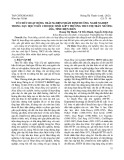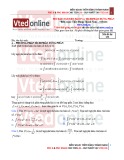Long path lemma concerning connectivity and independence number
Shinya Fujita∗
Alexander Halperin†
Colton Magnant‡
Submitted: May 10, 2010; Accepted: Nov 26, 2011; Published: Jul 22, 2011 Mathematics Subject Classification: 05C35
Abstract
.
n, (k−1)(n−k) α
n
+ k
n, (k−1)(n−k) α
+ k
.
We show that, in a k-connected graph G of order n with α(G) = α, between any + k pair of vertices, there exists a path P joining them with |P | ≥ min This implies that, for any edge e ∈ E(G), there is a cycle containing e of length o at least min . Moreover, we generalize our result as follows: for any choice S of s ≤ k vertices in G, there exists a tree T whose set of leaves is S n with |T | ≥ min
o n, (k−s+1)(n−k) α
o
n
1 Introduction
In this work, we present a tool which we believe will be useful in many applications. Much work has been devoted to finding long paths and cycles in graphs. In particular, in [4], O, West and Wu recently proved a conjecture by Fouquet and Jolivet [3] stated as follows.
α
}. Theorem 1 ([4]) Let k ≥ 2 and let G be a k-connected graph of order n with α(G) = α. Then there is a cycle in G of length at least min{n, k(n+α−k)
In various situations including this work, it often becomes necessary to find a long path between a chosen pair of vertices. For this reason, O, West and Wu proved the following theorem which they used in their proof of the conjecture.
∗Department of Mathematics, Gunma National College of Technology. 580 Toriba, Maebashi, Gunma,
Japan 371-8530. Supported by JSPS Grant No. 20740068
†Department of Mathematics, Lehigh University, Bethlehem, PA 18015 USA ‡Department of Mathematical Sciences, Georgia Southern University, Statesboro, GA 30460 USA
the electronic journal of combinatorics 18 (2011), #P149
1
Theorem 2 ([4]) Let G be a k-connected graph for k ≥ 1. If H ⊆ G and u and v are distinct vertices in G, then G contains a u, v-path P such that V (H) ⊆ V (P ) or α(H − P ) ≤ α(H) − (k − 1).
We also use this theorem and, following the proofs presented in [4], we prove the following lemma which is our main result.
α
Lemma 1 Let k ≥ 1 be an integer and let G be a graph of order n with κ(G) = k and α(G) = α. Then for any pair of vertices u, v in G, there exists a u, v-path of order at least min{n, (k−1)(n−k) + k}.
Our hope is that this lemma may be applied to produce other results like Theorem 3, which follows immediately from Lemma 1 by choosing u and v to be the ends of e.
in G containing the edge e. Theorem 3 Let k ≥ 2 be an integer and let G be a k-connected graph of order n with α(G) = α. Then for any edge e ∈ E(G), there exists a cycle of length at least min + k n, (k−1)(n−k) α
o n Lemma 1 can be generalized to the following result concerning large trees with specified sets of leaves. Let ℓ(T ) denote the set of leaves in a tree T .
. + k Theorem 4 Let k and s be integers with 2 ≤ s ≤ k and let G be a k-connected graph of order n with α(G) = α. Then for any set of s vertices Vs = {v1, . . . , vs} ⊆ G, there exists a tree T ⊆ G with Vs = ℓ(T ) and |T | ≥ min n, (k−s+1)(n−k) α
n o The proofs of Lemma 1 and Theorem 4 are presented in Section 3. As we will observe in Section 4, our results are all best possible.
2 Preliminaries
In our proof, we use the following corollary to break the problem into cases. We also state and prove a path version of Theorem 6. Both of these results come from [4].
Corollary 5 ([4]) If a graph G admits no vertex partition (V1, V2) such that α(G) = α(G[V1]) + α(G[V2]), then G is 2-connected or G ∈ {K1, K2}. Also, for distinct vertices u, v ∈ G, there is a u, v-path P such that α(G − P ) < α(G).
k − 1 and α(H − C ′) ≤ α(H) − 1.
Theorem 6 ([4]) Let k be an integer greater than 1. If C is a cycle with size at least k in a k-connected graph G, then for any non-empty subgraph H ⊆ G − C, there exists a cycle C ′ in G such that |C − C ′| ≤ |C|
We will also make use of the following classical result of Chv´atal and Erd˝os [2]. A graph is said to be hamiltonian connected if, between any pair of vertices, there exists a path covering the entire graph.
Theorem 7 ([2]) For any graph G, if κ(G) > α(G), then G is hamiltonian connected.
the electronic journal of combinatorics 18 (2011), #P149
2
Following the notation of [4], let P be a path and u and v be vertices in P . Define P (u, v) to be the subpath of P strictly between (not including) u and v. Also, for a vertex v and a set of vertices or subgraph A, define a (v, A) k-fan to be a set of k paths from v to A which are all pairwise vertex disjoint except at v. All other standard notation comes from [1].
3 Proofs of our Main Results
We begin by proving a key lemma used to obtain our main result. The main idea of the proof is based on that of Theorem 6.
Lemma 2 Let k ≥ 2 be an integer, and suppose G is a k-connected graph containing vertices u, v. If P is a u, v-path of order at least k in G, then for any non-empty subgraph H ⊆ G\P , there is a u, v-path P ′ in G such that |P \P ′| ≤ |P |−k k−1 and α(H \P ′) ≤ α(H)−1.
Proof: Suppose there exists a subgraph H for which there is no desired path P ′ and choose H to be the smallest such subgraph. By Corollary 5, either
(1) H can be bipartitioned into non-empty subgraphs H1 and H2 so that α(H) = α(H1)+ α(H2), or
(2) H is 2-connected or H ∈ {K1, K2}. Also, for any distinct vertices x, y ∈ H, there exists an x, y-path Pxy in H such that α(H \ Pxy) < α(H).
If (1) holds, we simply apply Lemma 2 on H1 (since H was the smallest counterex- ample) and obtain a path P ′ satisfying the desired conditions. Hence we may assume (2) holds.
Let B be the block of G \ P containing H. First we assume |B| ≥ k. By Menger’s Theorem, there exist k vertex-disjoint paths from P to B. Choose the shortest such set of paths, meaning that each path contains exactly one vertex of B and one vertex of P . This means that there must exist a pair of these paths, say P1 = p1 . . . b1 and P2 = p2 . . . b2 for pi ∈ V (P ) and bi ∈ V (B) such that there are at most |P |−k k−1 vertices between p1 and p2 on P . Since B is 2-connected, there exist vertex-disjoint paths Pbi in B from bi to hi ∈ V (H) for i = 1, 2. Note that h1 = h2 is only possible if |H| = 1. (Suppose Pbi ∩ H = hi.) By (2), there is a path PH in H from h1 to h2 for which α(H \ PH) < α(H). Then P ′ = (P \ P (p1, p2)) ∪ (P1 ∪ Pb1 ∪ PH ∪ Pb2 ∪ P2) is the desired path. Hence, we may assume |B| < k.
Let V (B) = {b1, . . . , bℓ}, where we have assumed ℓ < k. Note that we may possibly have ℓ = 1. Let C be the component of G \ P containing B. Let S = {p1, . . . , pm} be the set of vertices of P (in order along P ) with at least one neighbor in C. Note that, by Menger’s Theorem, m ≥ k.
For each edge e from pi to C, there exists a unique vertex bj ∈ B such that there is a unique path Qi,j from bj to pi containing e with all interior vertices in C \ B. Let Xj be the set of vertices pi for which such a path Qi,j exists. Note that the sets {Xj} are not necessarily disjoint. Also note that, since B is a block, Qi,j and Qi′,j′ are internally disjoint when j 6= j′. Call a segment P (pi, pj) for i < j large if pi ∈ Xi′ and pj ∈ Xj′ for some i′ 6= j′. Otherwise, as long as the segment P (pi, pj) is not contained in a large segment, it will be called small. Using the same argument as above, the following fact is immediate.
the electronic journal of combinatorics 18 (2011), #P149
3
Fact 1 For any large segment P (pi, pj), we have
. |P (pi, pj)| > |P | − k k − 1
k−1
Let t be the number of segments P (pi, pi+1) for 1 ≤ i ≤ m which are large. Since large vertices, we see that segments contain at least |P |−k+1
|P | ≥ t + k, |P | − k + 1 k − 1 (cid:18) (cid:19)
which implies that t < k − 1. For each bi ∈ B, there exists a (bi − P ) k-fan. Choose such a fan so that each path intersects P in exactly one vertex. Let v1, . . . , vk (in this order on P ) be the vertices of P at the ends of this fan. For each pair vj, vj+1, we already know that vj, vj+1 ∈ Xi, but if one of these is also in Xi′ for some i′ 6= i, then P (vj, vj+1) must be a large segment of P . This means that, for each vertex in B, there are at least k − 1 − t corresponding small segments of P . Since the ends of these small segments corresponding to bi are all in Xi, these segments must then be disjoint from all small segments corresponding to bj for j 6= i since the ends of those segments would be in Xj. Therefore there are (k − 1 − t)ℓ small segments all pairwise disjoint. This implies that the average order of small segments is at most
|P |−k+1 k−1
|P | − t − k . (cid:16) (cid:17) (k − 1 − t)ℓ
By the pigeonhole principle, if we choose the shortest small segment corresponding to each vertex bi ∈ B, then the sum of the orders of these shortest segments is at most
|P |−k+1 k−1
|P | − t − k . ≤ (cid:16) (cid:17) (k − 1 − t) |P | − k k − 1
We now replace each of these small segments with the corresponding bi using the paths Qi,j and Qi,j+1 for the appropriate choice of j. This creates a new u, v-path P ′ such that H ⊆ B ⊆ P ′ and |P \ P ′| ≤ |P |−k (cid:3) k−1 .
Before our next lemma, we observe an easy fact without proof.
Fact 2 Let G be a k-connected graph for k ≥ 2 and let u and v be two distinct vertices in G. Then for any u, v-path P with |P | < k, there is another u, v-path P ′ with |P ′| ≥ k such that P ⊆ P ′.
ℓ
Lemma 3 Let G be a graph with κ(G) = k and α(G) = α. If u, v are two vertices in G, ℓ is an integer satisfying 0 ≤ ℓ ≤ α − k + 1, then there exists a set of u, v-paths P0, . . . , Pℓ satisfying:
i=0 [
the electronic journal of combinatorics 18 (2011), #P149
4
1. α G \ ≤ α − k + 1 − ℓ Pi !
j−1
j=0 [
2. for 1 ≤ i ≤ ℓ Pj ≤ |P0|−k k−1
i=0Pi be so that α(H) ≤ α − k + 1 − (ℓ − 1). Assume α(H) ≥ 1 since otherwise we could simply set Pℓ = P0. By Lemma 2 with P0 = P (note that Fact 2 implies we may assume |P0| ≥ k), there is a u, v-path P ′ such that |P0 \ P ′| ≤ |P0|−k k−1 and α(H \ P ′) ≤ α(H) − 1 ≤ α − k + 1 − ℓ.
Pi \ (cid:12) (cid:12) (cid:12) (cid:12) (cid:12) (cid:12) (cid:12) (cid:12) (cid:12) (cid:12) Proof: Induct on ℓ. If ℓ = 0, Theorem 2 gives a u, v-path P0 with α(G\P0) ≤ α−k+1. Now suppose we have u, v-paths P0, . . . , Pℓ−1 satisfying Properties 1 and 2 for ℓ − 1. Let H = G \ ∪ℓ−1
Case 1 |P ′| ≤ |P0|
k−1 , so we can set P ′ = Pℓ to satisfy
i=0Pi the desired properties. (cid:12) (cid:12)
P ′ \ ∪ℓ−1 Then ≤ |P ′ \ P0| ≤ |P0 \ P ′| ≤ |P0|−k
(cid:12) (cid:12) Case 2 |P ′| > |P0|
0 = P ′ and P ′
i=0P ′ i
Relabel the paths as follows: P ′ G \ ∪ℓ
i \ P ′
0| = |P0 \ P ′| ≤ |P ′|−k
i = Pi−1 for 1 ≤ i ≤ ℓ. This new labelling ≤ α − k + 1 − ℓ so Property 1 is satisfied. For Property 2, first k−1 as desired. For 2 ≤ i ≤ ℓ, we have
i−2
i−1
gives α consider the case i = 1. |P ′ (cid:0) (cid:1)
i \
j=0 [
j=0 [
≤ ≤ ≤ Pj P ′ j |P0| − k k − 1 |P ′ 0| − k k − 1
(cid:3) so this labelling satisfies Properties 1 and 2, and we have our desired result. (cid:12) (cid:12) (cid:12) (cid:12) (cid:12) Pi−1 \ (cid:12) (cid:12) (cid:12) (cid:12) (cid:12) (cid:12) (cid:12) (cid:12) (cid:12) (cid:12) P ′ (cid:12) (cid:12) (cid:12) (cid:12) (cid:12)
Using these lemmas, the proof of our main result is easy. Proof of Lemma 1: For k = 1, the result is trivial so we will assume k ≥ 2. When k > α, the assertion holds by Theorem 7. Thus, we may also assume α ≥ k.
ℓ
i−1
Set ℓ = α − k + 1 and apply Lemma 3. By Property 1, the set of paths P0, . . . , Pℓ must cover all of V (G). Using Property 2, this implies
. Pj ≤ |P0| + (α − k + 1) n = |P0| + |P0| − k k − 1 (cid:19)
α
(cid:3) + k. (cid:18) j=0 [ Solving for |P0|, we get get the desired result |P0| ≥ (k−1)(n−k) (cid:12) (cid:12) (cid:12) (cid:12) (cid:12) Pi \ i=1 (cid:12) (cid:12) X (cid:12) (cid:12) (cid:12)
the electronic journal of combinatorics 18 (2011), #P149
5
Proof of Theorem 4: This proof is by induction on s. If s = 2, the result follows immediately from Lemma 1. Now suppose s > 3 and consider G \ vs. This graph has κ(G \ vs) ≥ k − 1 and we will assume α(G \ vs) = α(G) (otherwise a stronger result is possible). By induction on s, there exists a tree Ts−1 ⊆ G with ℓ(Ts−1) = {v1, . . . , vs−1} and
n − 1, + k − 1, + k |Ts−1| ≥ min (k − s + 2)(n − k − 1) α (cid:26) (cid:27)
+ k − 1 ≥ min n − 1, (k − s + 1)(n − k) α (k − s + 1)(n − k) α (cid:27) (cid:26)
as long as n ≥ 2k + 2 − s − α. Otherwise, if we assume n < 2k + 2 − s − α, then since n ≥ k + 1, if we let H = G \ {v3, v4, . . . , vs}, we have κ(H) ≥ α + 1. By Theorem 7, this means that H is hamiltonian connected so we can find a path P from v1 to v2 using all of H. Since G is k-connected, each vertex vi for 3 ≤ i ≤ s has at least k paths to P . Since k ≥ s, there is an edge from each vi to P \ {v1, v2}, forming the desired tree of order n. Hence, we may suppose the above inequality holds.
In G, there are k disjoint (except at vs) paths from vs to Ts−1 so there is at least one such path Q which avoids the set {v1, . . . , vs−1}. Hence, the tree T = Ts−1 ∪ Q is the (cid:3) desired tree with |T | ≥ |Ts−1| + 1.
4 Conclusion
α
The results contained in this work are all sharp by the following example. Let C = Kk and let Hi = K n−k for 1 ≤ i ≤ α where we assume α divides n − k. Let G = C + (∪Hi) where + is the standard join operation such that V (A + B) = V (A) ∪ V (B) and E(A + B) = E(A) ∪ E(B) ∪ {u, v : u ∈ A, v ∈ B}. Choose u, v ∈ C and let P be a u, v-path that uses all vertices of C and all of H1, . . . , Hk−1. This is the longest u, v-path in G, which shows that Lemma 1 is sharp. The same example, with the inclusion of the edge uv to complete a cycle, shows that Theorem 3 is sharp.
For Theorem 4, choose v1, . . . , vs from C to obtain the desired bound. In this situation, because these vertices must be leaves of the constructed tree, we may use the vertices of at most k − s + 1 components Hi in building T . Note also that if s > k, a similar result cannot hold because, if we choose all of C and at least one vertex of G \ C, at least one vertex of C must not be a leaf of a tree including these vertices.
The authors hope that the results contained in this work may be applied in other works. Like Theorems 3 and 4 we believe that many results will follow from this work and perhaps other proofs may be simplified through use of Lemma 1.
Acknowledgement
the electronic journal of combinatorics 18 (2011), #P149
6
The authors would like to thank Garth Isaak for help on this and related projects.
References
[1] G. Chartrand and L. Lesniak. Graphs & Digraphs. Chapman & Hall/CRC, Boca Raton, FL, fourth edition, 2005.
[2] V. Chv´atal and P. Erd˝os, A note on Hamiltonian circuits, Discrete Math 2, (1972). 111-113.
[3] J.L. Fouquet and J.L. Jolivet. Probl`emes combinatoires et th´eorie des graphes Orsay, Probl`emes. 1976.
the electronic journal of combinatorics 18 (2011), #P149
7
[4] S. O, D. B. West, and H. Wu. Longest cycles in k-connected graphs with given inde- pendence number. J. Combin. Th. (B), In Press.



































